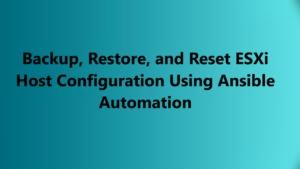In the ever-evolving landscape of cloud-native technologies, Tanzu Kubernetes Grid (TKG) stands out as a beacon of innovation, empowering organizations to harness the full potential of Kubernetes within their VMware vSphere environments. With the release of vSphere 8, the integration of Tanzu Kubernetes Grid heralds a new era of seamless orchestration and management for containerized workloads. In this comprehensive guide, we delve deep into the intricacies of Tanzu Kubernetes Grid on vSphere 8, exploring its features, benefits, and implementation best practices.
Understanding Tanzu Kubernetes Grid (TKG)
At its core, Tanzu Kubernetes Grid is a Kubernetes distribution optimized for enterprise-grade container orchestration. Designed to streamline the deployment and management of Kubernetes clusters, TKG provides a consistent and secure environment for running modern applications across on-premises, public cloud, and edge infrastructure.
Integration with vSphere 8: The Power of Synergy
With the integration of Tanzu Kubernetes Grid into vSphere 8, VMware unlocks a wealth of synergistic benefits for organizations seeking to leverage Kubernetes within their existing vSphere environments. By seamlessly embedding Kubernetes capabilities directly into vSphere, VMware simplifies the deployment, management, and scaling of containerized applications, all within familiar vSphere workflows.
Workload Availability Zones are used to isolate workloads across vSphere clusters. supervisor clusters and Tanzu Kubernetes clusters can be deployed across zones to increase the availability of the clusters by ensuring that nodes are not sharing the same vSphere clusters.
ClusterClass is a way to declaratively specify your cluster’s configuration through the open-source ClusterAPI project.
PhotonOS and Ubuntu base images can be customized and saved to the content library for use in Tanzu Kubernetes clusters.
Pinniped Integration comes to the supervisor clusters and Tanzu Kubernetes clusters. Pinniped supports LDAP and OIDC federated authentication. You can define identity providers that can be used to authenticate users to the supervisor clusters and Tanzu Kubernetes clusters.
Workload Availability Zones allows Supervisor Clusters and Tanzu Kubernetes Clusters to span across vSphere Clusters for increased availability. vSphere Namespaces span the Workload Availability Zones to support Tanzu Kubernetes Clusters being deployed for increased availability across zones.

Key Features and Capabilities
1. Native Integration:
Tanzu Kubernetes Grid seamlessly integrates with vSphere 8, allowing users to deploy and manage Kubernetes clusters directly from the vSphere interface. This native integration streamlines operations and eliminates the need for disparate management tools.
2. Automated Lifecycle Management:
With Tanzu Kubernetes Grid on vSphere 8, administrators benefit from automated lifecycle management capabilities, including cluster provisioning, scaling, and updates. This ensures that Kubernetes clusters remain healthy and up-to-date with minimal manual intervention.
3. Multi-Cluster Management:
Tanzu Kubernetes Grid enables centralized management of multiple Kubernetes clusters across diverse environments, including vSphere-based data centers, public clouds, and edge locations. This unified management approach simplifies governance and enhances operational efficiency.
4. Security and Compliance:
Built-in security features, such as identity and access management, network policies, and encryption, ensure that containerized workloads deployed on Tanzu Kubernetes Grid remain secure and compliant with regulatory requirements. This robust security posture instills confidence in organizations deploying mission-critical applications.
Implementation Best Practices
1. Assess Workload Requirements:
Before deploying Tanzu Kubernetes Grid on vSphere 8, it’s essential to assess workload requirements, including resource utilization, performance expectations, and scalability needs. This ensures that Kubernetes clusters are provisioned optimally to meet application demands.
2. Plan for High Availability:
Design Kubernetes clusters with high availability in mind, leveraging vSphere features such as vSphere HA and DRS to ensure resilience and fault tolerance. Distributing cluster nodes across multiple vSphere hosts minimizes the risk of downtime and enhances application reliability.
3. Optimize Networking and Storage:
Configure networking and storage infrastructure to align with Kubernetes requirements, ensuring low latency, high throughput, and data persistence for containerized workloads. Leverage vSphere networking and storage capabilities to optimize performance and streamline operations.
4. Implement Monitoring and Logging:
Deploy monitoring and logging solutions to gain visibility into the performance and health of Kubernetes clusters running on vSphere 8. Integrated monitoring tools, such as vRealize Operations, enable proactive monitoring, alerting, and troubleshooting to ensure optimal cluster performance.



